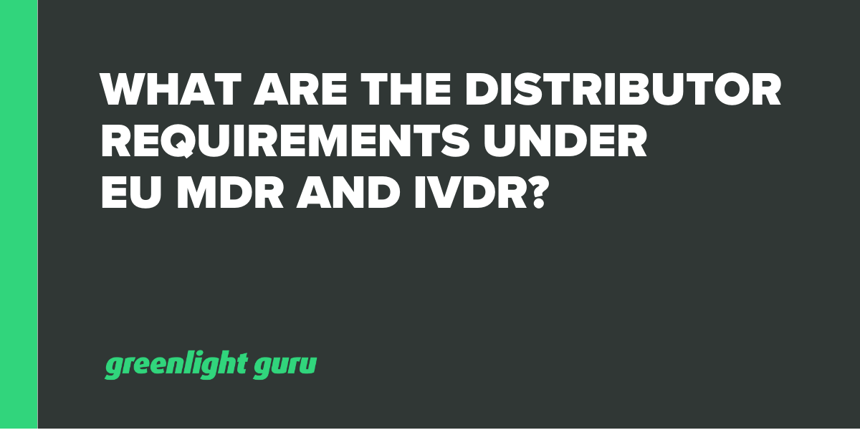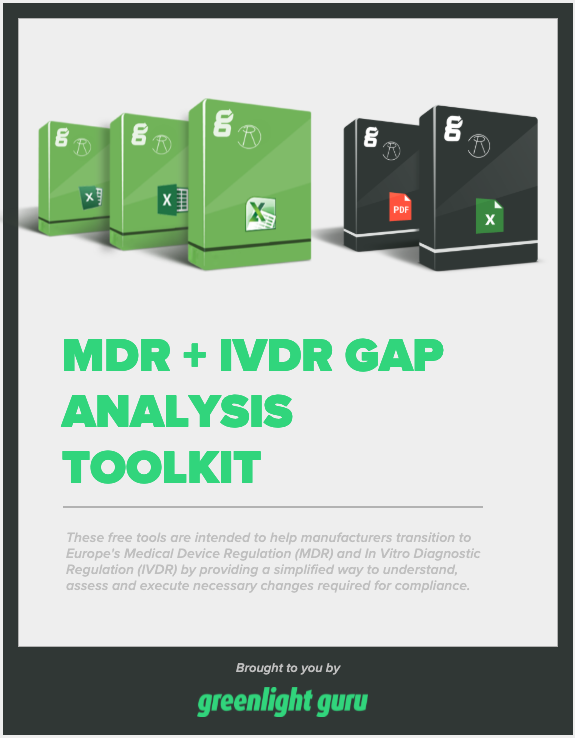What are the Distributor Requirements under EU MDR and IVDR?

If you read the European Medical Device Regulation (EU MDR) and the European In Vitro Diagnostic Regulation (EU IVDR), you’ll notice that both regulations use the term “economic operator” quite a few times.
That’s because economic operators are the entities that make up the medical device supply chain. Manufacturers, authorized representatives, importers, and distributors all play a role in ensuring that safe, high-quality medical devices make it to their end users.
Today, I want to focus on that last economic operator: the distributor. There are a number of new distributor requirements in EU MDR and EU IVDR, and in this article, I’m going to explain those requirements and the responsibilities they entail for medical device distributors in Europe.
Who do distributor requirements apply to?
Before we can get into the responsibilities of distributors under EU MDR and IVDR, we need to properly define a distributor. This is important because the two economic operators have many overlapping responsibilities and sometimes perform the same actions.
MDR defines a distributor as ”any natural or legal person in the supply chain, other than the manufacturer or the importer, that makes a device available on the market, up until the point of putting it into service.”
What actually makes a distributor different from an importer, however, is their position in the supply chain.
-
The importer places medical devices on the EU market for the first time.
-
Distributors make these devices available on the market for the second time (or as many times as it takes until they reach the end user).
Based on these definitions, a company cannot be both an importer and a distributor at the same time. An importer can directly supply a medical device to its end users, but it will still be identified as an importer, not a distributor.
The Medical Device Coordination Group (MDCG) is currently working on a guidance document for importers and distributors, which will hopefully be published by the end of 2021. However, for now you can still refer to sections 3.3 and 3.4 of The “Blue Guide” on the implementation of EU product rules to learn more about the difference between importers and distributors.
What is required of distributors before they place a device on the market?
The responsibilities of distributors can be found in Article 14 of both EU MDR and EU IVDR, which are identical. Thus, you can assume that any reference to a “device” covers both medical devices and in vitro diagnostics (IVDs).
Before a distributor places a device on the market, there are a number of steps they must take to ensure its safety and authenticate its provenance. Distributors must ensure that:
-
The product has a CE marking.
-
A declaration of conformity has been issued for the product.
-
The device is accompanied with all of the information to be supplied by the manufacturer.
-
The name and address of the importer is on the product, packaging, or accompanying information.
-
The manufacturer has issued a unique device identifier (UDI).
-
The product appears to conform to all requirements of the Regulation.
In order to meet these requirements, the distributor will need to use an appropriate sampling method that is representative of the devices the distributor is supplying.
Additionally, while the device is in their care, the distributor must make sure that they are in compliance with all the storage and transportation conditions stipulated by the manufacturer.
What are the documentation and reporting requirements for distributors under MDR and IVDR?
A distributor’s responsibilities don’t end once they’ve made a device available on the market. In fact, there are a number of requirements for documentation and reporting that distributors must follow carefully.
These include:
-
Keeping a register of complaints. Not only do distributors have to keep a record of complaints from healthcare professionals and patients, they must also immediately forward that information to the manufacturer and, in some cases, the authorized representative and importer.
-
Informing the manufacturer of any nonconformances. Again, the regulations state that when distributors believe a device is not in conformance with regulations, they “shall inform the manufacturer and, where applicable, the manufacturer’s authorized representative, and the importer.”
-
Reporting serious incidents or serious risks to competent authorities. In the case of serious risk or incidents, the distributor must also inform the competent authority of their respective member state. Additionally, distributors must be ready to provide all of their documentation demonstrating the conformity of a device to the competent authority upon request.
-
Achieving a high level of traceability of devices. The regulations also state that distributors must be able to identify for competent authorities:
-
Every economic operator they supplied a device to
-
Every economic operator that supplied them a device
-
Every healthcare professional or institution they have directly supplied a device to
If all of these responsibilities are fulfilled, it should result in the quick tracing of any nonconforming devices and timely corrective actions that keep patients and providers safe.
Greenlight Guru streamlines all your documentation and reporting requirements
Distributors have different responsibilities under MDR and IVDR than manufacturers or even importers. However, the documentation and reporting requirements are extensive, and distributors would be wise to have a quality management system (QMS) in place that streamlines all of it.
Greenlight Guru’s Quality Management System comes with Intelligent Document Management built-in. When you use our platform, you’ll be able to efficiently navigate your documents and quickly find exactly what you need, exactly when you need it.
Get your free demo of Greenlight Guru today!
Etienne Nichols is the Head of Industry Insights & Education at Greenlight Guru. As a Mechanical Engineer and Medical Device Guru, he specializes in simplifying complex ideas, teaching system integration, and connecting industry leaders. While hosting the Global Medical Device Podcast, Etienne has led over 200...
Related Posts
Who are the Economic Operators & What Does EU MDR Require of Them?
Transitioning to IVDR: The New EU Regulation for In Vitro Diagnostic Medical Devices
How to Make Your QMS Comply with EU MDR and IVDR
Get your free resource
MDR + IVDR Gap Analysis Toolkit
.png?width=250&name=MDR%20+%20IVDR%20Gap%20Analysis%20Toolkit%20(1).png)









